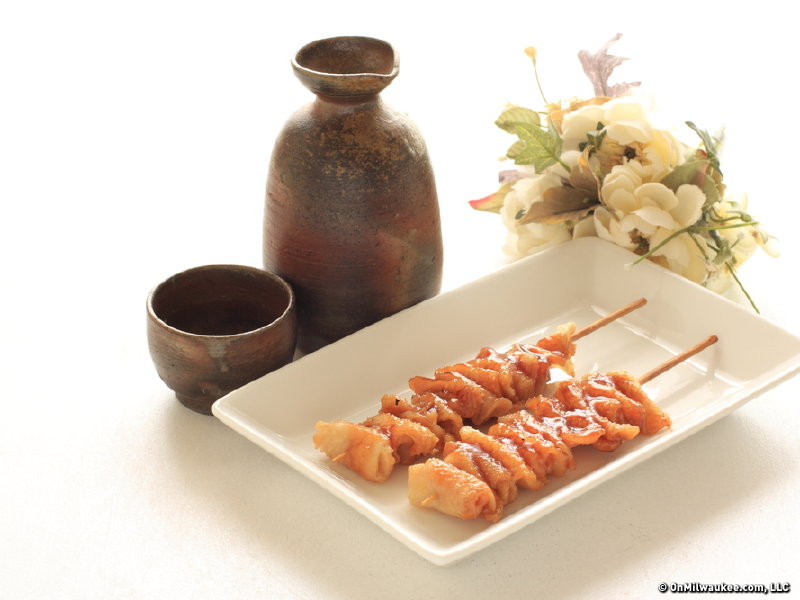When Blue Jacket announced that it would host izakaya-themed events every Wednesday evening from 9 p.m. to midnight, I was pretty excited.
Izakayas are ubiquitous in Japan; but over the past few years they’ve begun to creep into larger food cities across the U.S. And it seems about time for Milwaukee to get a taste of the trend.
Executive Chef Matt Kerley agreed.
"When I started here, Ira really wanted to do a pho night," he told me. "I loved the idea of it. And I love making pho. But, in the end … one or two other places were doing it, and Justin Carlisle started doing late night ramen at Ardent. I just didn’t want to be another place doing noodle soup. So, we did it for four or five weeks. It went over pretty well, and it was a lot easier. But, it just started to feel a little forced."
Instead, Kerley reached back to his days working in San Francisco, and conjured up a new plan.
"I really wanted to do dim sum; I really miss that. But, it just wasn’t feasible," he tells me. "Izakaya, however, was accessible. The old tradition is that it’s more of a tea house, where you’d ultimately order small plates for sharing. But, what was starting to happen in San Francisco is what’s now happening all over with gastropubs … they’ve taken a turn to be more lounges and nightclubs. People are trying to focus on sake, less on the tea and formality, and more on the food."
The term izakaya literally means: "sitting in a sake shop." It’s a word that refers to what is essentially a Japanese tavern – a place to grab a drink and take in a few small dishes. It’s a place to sit back and relax with friends.
In France, you might call it a bar à vins, in Spain a tapeo. Here in the U.S., you’re more likely to compare it to a pub or a lounge.
At Blue Jacket, izakaya veers further toward a nightclub vibe – with the addition of a DJ, some deep bass, and a good number of industry folks just getting off of work and celebrating the end of the work day.
"It’s loud music. A late night vibe," says Kerley. But, it’s also about the food.
Every izakaya menu is different, however popular items can include edamame, tofu dishes, sashimi, yakitori and yakisoba. The cacophony of flavors will include balance – something raw, something pickled, something fried, something simmered. And, in Japan, a good izakaya will serve deliciously fresh seasonal fare that reflects a local flair.
Like most bar food, good izakaya fare is also engineered to be especially delicious with sake – or in the U.S. – beer, wine or cocktails.
But, for Kerley, it’s also about making people think – and helping them to try something new.
"I think one of my challenges coming to Milwaukee," he says, "is that in San Francisco you could do anything with any ingredient and people would be lining up around the corner to try it. In Milwaukee you don’t necessarily have that. There’s a great pocket of folks really coming around and expanding their palates, but it can be a struggle."
Kerley says he gained a lot of great exposure to Asian ingredients under the tutelage of Sean O’Brien at Myth in San Francisco.
"I had a great introduction to a lot of amazing ingredients," he recalls. "There’s a lot umami that isn’t easy to capture using other ingredients. There are clean, simple sauces that just make a lot of sense to me. So, I knew izakaya would be fun for me."
Another aspect that made a great deal of sense to Kerley was the idea of creating a menu that really introduced people to some of the alternatives to what we see as typical "farm to table" dining.
"We need to do what’s best ethically and financially, first and foremost," he says. "But, the onus does lie on us, as chefs, to really push the envelope – whether it’s supporting local organic farms or stretching the palate. I think essentially that’s what the farm to table movement is – and the more we turn people on to new things, the more we all help each other."
The first dish Kerley introduced was one of his favorites, agedashi tofu – fried tofu served in a dashi broth.
"It’s just delicious," he says. "We make ours with dried shiitakes, tamari, nori and scallion. We’ve also made a variation using crisped pork belly in place of the tofu. THAT was killer."
Typically, he says, he makes three or four dishes for Wednesday izakaya. They might include yakitori (chicken skewers) or kushiyaki – skewers made with squid or octopus. It could also be a bowl of donburi, a traditional rice dish with scrambled egg, mirin and sesame seeds, along with additions like salmon or unagi, depending on what’s available seasonally and what can be procured in an ethical and sustainable manner.
Pricing for the dishes runs from $2 for a bowl of miso soup to $7 for miso soba, with dishes falling everywhere in between.
"These are about the flavors, and what I’m trying to hand out is an experience," Kerley explains. "I want people to try out something new, and I want us to always be a little bit on our toes too."
Kerley says Blue Jacket plans to continue offering izakaya for the next six to eight weeks, and that the concept will evolve. He says he’ll start by bringing in some high quality sake this week, and will keep pushing new and different elements each week.
"We have a really solid cocktail menu here," says Kerley. "But, we’re just beginning to enter into the arena of working with pairings for the izakaya. So, introducing some of these Asian ingredients to the bartenders will be a next step."
As a passionate champion of the local dining scene, Lori has reimagined the restaurant critic's role into that of a trusted dining concierge, guiding food lovers to delightful culinary discoveries and memorable experiences.
Lori is an avid cook whose accrual of condiments and spices is rivaled only by her cookbook collection. Her passion for the culinary industry was birthed while balancing A&W root beer mugs as a teenage carhop, fed by insatiable curiosity and fueled by the people whose stories entwine with every dish. Lori is the author of two books: the "Wisconsin Field to Fork" cookbook and "Milwaukee Food". Her work has garnered journalism awards from entities including the Milwaukee Press Club. In 2024, Lori was honored with a "Top 20 Women in Hospitality to Watch" award by the Wisconsin Restaurant Association.
When she’s not eating, photographing food, writing or planning for TV and radio spots, you’ll find Lori seeking out adventures with her husband Paul, traveling, cooking, reading, learning, snuggling with her cats and looking for ways to make a difference.







